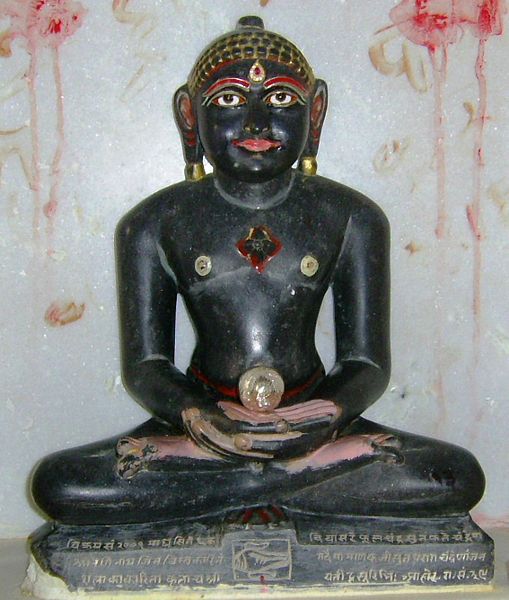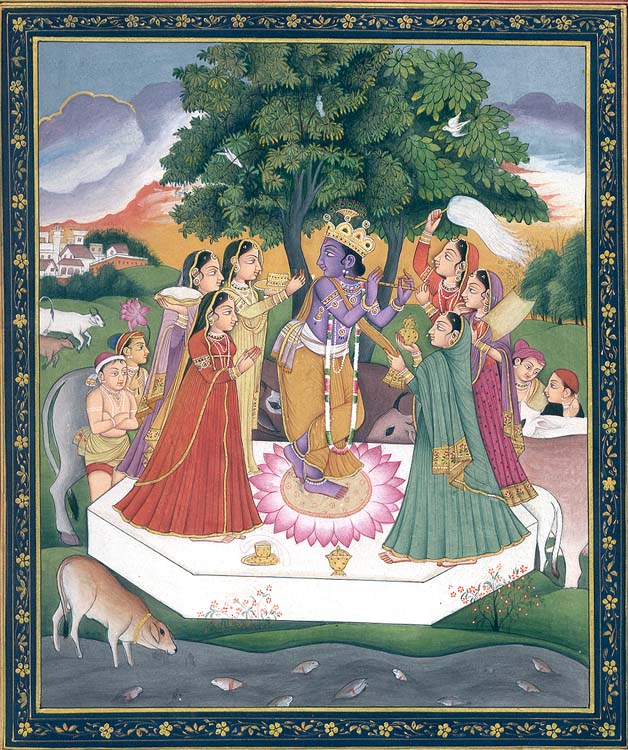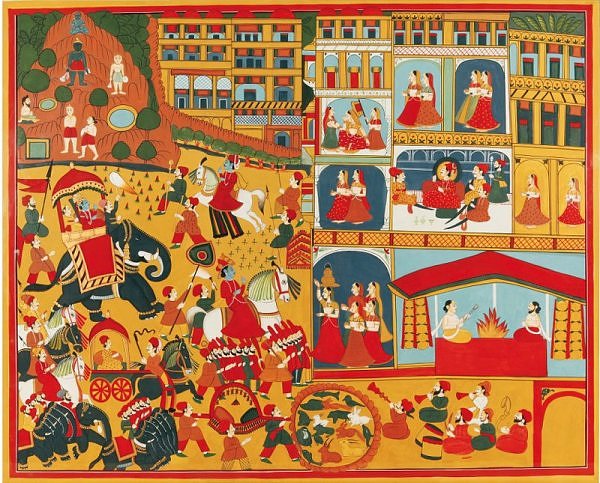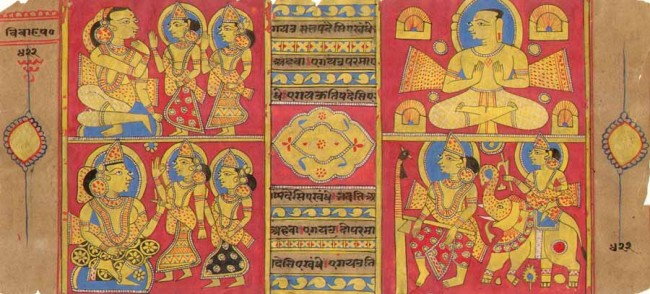Lord Neminath and Rajimati
By the time of Mahabharat some socio-political and religious conditions in India had deteriorated. Ethical values, e.g. standards of restraints, monogamy etc. which were set up during Ramayan period, had been neglected. Polygamy was almost the order of the day and some rulers and men of means used to marry as many wives as they could afford. Even the old people with grown up sons did not hesitate to marry young girls. There were also cases of polyandry. Rulers were getting powerful. They were maintaining large armies and used to wage wars for expanding their territories.

Stone sculpture of Jina Neminath (Arishtanemi), identifiable by the depiction of a conch-shell on the front of the pedestal.
Jarasangh, the king of Magadh was the most powerful king. He was aspiring to become the lord of the entire Bharatkhand. Most of the other rulers vied with each other for his favor. There were also tyrant kings like Kans who could show utmost cruelty to the persons suspected of being against his interests. Hunting was the favorite pastime of warrior class and gambling was considered respectable game. Animals were sacrificed on the altar of religious rites and non-vegetarianism had become popular. It was the right time for a great saint to come forth and teach religion afresh.
Yadav clan had mostly settled on the bank of Yamuna. Mathura and Shauripuri in the present western Uttar Pradesh were their major centers of concentration. Yadav prince Samudravijay was ruling over Shauripuri, his wife’s name was Shivadevi. They had a son named Nemikumar, who was born sometimes before Mahabharat. He was the future Jina Lord Neminath. When he was in the womb of his mother, she had dreamt of series of black jewels called Arishta. Therefore he is also known as Arishtanemi. Neminath was a cousin and close associate of Shri Krishna.

Painted image of Shri Krishna, who was the cousin of Neminath, surrounded by the Gopis.
Under the leadership of Shri Krishna, Yadavs were challenging the authority of Jarasangh who was therefore planning to invade Mathura. Not being able to withstand his pressure, Yadavs migrated to Dwarka in Saurashtra. Nemikumar’s family also migrated with them to Dwarka.
Like Shri Krishna, Nemikumar too was dark complexioned, but handsome and charming. Many girls were attracted towards him. Nemikumar was however introvert and did not develop much attachment for the worldly life. He stayed more introspective as he was inclined towards spiritual life.
At that time, Ugrasen was the king of Junagadh which is situated at the foot of Mount Girnar in Saurashtra. By his wife Dharini he had a daughter who was named Rajimati. She was popularly known as Rajul. She grew to be a very beautiful and graceful young girl. Many princes and other promising youths were eager to marry her.
When she came to know of Nemikumar, she got enamored of him and desired to marry him. Ugrasen thereupon sent the offer of her marriage to Nemikumar. This was a welcome proposal for Yadav chiefs. With considerable efforts, friends and family members of Nemikumar therefore persuaded him to accept the offer. Everyone was happy by his acceptance since Nemikumar and Rajul could make an ideal couple. The two were then officially engaged and a mutually convenient auspicious day was fixed for their wedding ceremony.
An elegantly decorated wedding party set off from Dwarka with the handsome Nemikumar as the bridegroom. Large number of people had joined the party because wedding ceremony was going to be gorgeous. Many of them were also keen to climb Mount Girnar. For king Ugrasen, wedding of his beloved daughter was a once in life time occasion. He had therefore made elaborate arrangements for making it as brilliant as possible.

Weddin procession of Neminath. The painting beautifully illustrates an episode of Neminath, the 22nd Tirthankara. While on the way to his marriage, Nemikumara saw many innocent animals penned up in enclosures. Upon learning that they were to be slaughtered for his wedding feast, Nemikumar returned from his wedding procession. The foreground of the painting shows enclosure with screaming animals. On the top left of the picture Neminath, as monk, is standing in a meditative pose (Reference: "Art of Enlightenment")
On the way also, adequate arrangements were made for the fun and food of the bridegroom party. When the party came in the vicinity of Mount Girnar and camped on the outskirts of Junagadh. They were appropriately received by Ugrasen and leading men of the city. It was a fine day. Weather was pleasant and cool sweet wind was blowing from Girnar. Everyone on either side was in rejoicing mood and was eager to watch the longed for wedding ceremony. Instructions were given for preparing tasty and delicious food for feasting of the bridegroom party.
Nemikumar too was in the pleasant mood. He was getting ready for the wedding ceremony. All of a sudden he heard some frightful shrieks and crying sounds. On inquiring, he learnt that it was emanating from birds and animals that were being slaughtered for feasting of his entourage.
He could not bear the idea of so much violence being caused on account of his wedding. He got pensive and started thinking how to prevent the violence. “Can’t there be a way of life that would extend peace and security to every living being?” he asked himself. As he thought deep into the matter, it was clear to him that he should better explore the way for well being of all.
He could visualize that after marriage he would get too much involved in worldly life. Then it would be hard for him to embark upon any exploration of that type. He could realize that it was the time for him to explore the truth that would lead to happiness of every being. He therefore decided to avoid getting married and to renounce the worldly life.
Everyone on bridegroom’s side was taken aback by his decision. How would they be in a position to explain his sudden decision to the bridal side? His friends and close relatives tried to dissuade him from his decision. He had however made up his mind. Their efforts therefore came to nothing. He calmly explained that it was his mission to explore bliss for all and they should not come in the way of fulfilling that mission. Thereupon he renounced everything and started for Mt. Girnar lonely and without any possession.
Neminath, as he came to be known thereafter, stayed on the mountain intensely meditating about the ultimate cause of all unhappiness. He could realize that ignorance of the true nature of oneself led to wrong perception and consequent wrong action that resulted in all sorts of miseries and pain. He therefore dwelt deep into the matter.

Mount Girnar
On the 56th day of renunciation he got fully enlightened and attained Kevalgnan (omniscience). He then set up afresh the religious order called Tirtha and became 22nd Tirthankar of the present Avasarpini. Thereafter he lived long enough to show the path of liberation.
At the time Nemikumar decided to renounce, Ugrasen and others were busy making preparations for the wedding. Rajul was being adorned by her girl friends. They were making jokes regarding her wedding and subsequent mating. She too was eagerly waiting for the arrival of her Nemikumar as the bridegroom. Then came the news that Nemikumar was not coming for the wedding. No one could understand his decision to renounce just before wedding.
Rajul was in utter grief, as if a calamity had overtaken her all of a sudden. Her friends tried to console her in that hour of crisis. Some of them started cursing Nemikumar for putting their beloved friend in the awkward position. Some others advised her to forget the unpredictable Nemikumar and look for other suitable match. Rajul had however admitted Nemikumar in her heart as the husband. She could not even think of any other person to take his place. She did not like any one to curse Nemikumar. She too had some spiritual orientation.
When she came to know of real cause of Nemikumar’s renouncement, she could overcome her grief. She realized that Nemikumar had left her for a commendable purpose. She could appreciate his mission. She thought that the best way for her was to follow in the footsteps of Nemikumar. Therefore she also renounced and left for meditation on Girnar.
Once while she was going from one place to another on the mountain, it started raining heavily. She took shelter under a tree but it was inadequate for the heavy downpour. By the time the rain stopped, she was totally drenched. She saw a cave nearby. She went inside, took off her clothes and started twisting them for drying them.
At that time Rathanemi (younger brother of Nemikumar), who had renounced earlier and who had once aspired to marry Rajul, was meditating in a corner of that cave. He opened his eyes at the sound of Rajul’s drying of her clothes. He could not believe that the girl he had dreamt of was standing there nude. He could not resist the temptation of getting her. He therefore left the meditation and expressed his love for her.
Nun Rajul was put in a very embarrassing situation. But she immediately regained her composure. Covering her body, she told him that his desire was not befitting for an ascetic like him. She explained that he should overcome his passion and stick to his renounced life. His succumbing to his instinct amounted to eating the vomited stuff. Even his brother Nemikumar, to whom she was once engaged, had left her in search for the truth. As such he should not deviate from the path that he had selected. Then Rathanemi realized the truth of her words. He begged her pardon and went away. In due course he attained Kevalgnan (omniscience).
Nun Rajul also spent the rest of her life as the head of nuns order of Lord Neminath and in the end attained divinity.

Marriage procession of Neminath
This leaf depicting a Jain theme, namely the marriage of Thirthankara Neminath, is in Kalpasutra format and adheres to an exact Gujarat Kalpasutra style. Rendered on a narrow strip of cloth or palm leaf a Kalpasutra folio revealed its theme by using abstract conventional symbols often derived from cardinal aspects of that theme. Details and superfluity were rigorously weeded out. Large protruding eyes, sharp noses and angular faces were characteristic features of figures in Kalpasutra folios, but the other eye protruding beyond the face even in a side pose, extra carved hung chin and wings-like projected sash were peculiarities of Gujarat Kalpasutra art. It is for using these stylistic features that this folio and the other one just above it fall in the Gujarat tradition of Kalpasutras.
Dividing the canvas space in five distinct compartments the artist has serialised his theme. As the tradition has it, the space in the centre has been used for the relevant text. It has the usual cosmic symbol of Jain concept. Both the upper and lower chambers on the left depict events preceding a marriage. In the upper one, two messengers are seen narrating to the would-be bride, Rajula, the particulars of Neminath, the proposed bride-groom, and seeking her consent to marriage. In the lower one the same proposal is being moved to the bride's mother after her daughter had given to it her consent.
The lower compartment on the right depicts the bride-groom, Thirthankara Neminath, proceeding to his bride's house for marrying her. He is riding a royal elephant beautifully painted and adorned with jewels like Indra's elephant Erawata. He is carrying in one of his hands a bouquet or a large flower exactly as one would carry a royal standard when proceeding to a marriage. The attendant piloting him holds in her hands the auspicious ax. The most significant is the presence of a wooden pole with a bird's or animal's head in front of them. As the tradition had it, it was by moving seven times around such an auspicious wooden khambha that a marriage was consecrated. Obviously the presence of this symbol suggests that the figure on elephant was a bride-groom on his errand to marry.
The compartment just above it houses the padmasana image of Thirthankara Neminath. He has renounced the world and is now the enlightened one. His long ears and the red lotus mark on his chest are indications of his having attained the thirthankarhood. For better depicting his enlightenment the artist has painted on all his four sides sun like radiating circles and houses like structures bursting with rays of glowing lights. They indicate that all his faculties and all within and without have exploded with light and he is enlightened.
As depict Jain texts, Neminath was a Yaduvanshi, the same as was Lord Krishna and the two were each other's kinsmen. Neminath was highly emotional and compassionate. When at his bride's house, he noticed a large number of cattle, thirsty, hungry and uncared for, retained inside a fold. They were all moaning miserably. Neminath asked the reason for retaining them. When he learnt that they were the part of dowry to be given to him, it deeply and painfully struck his mind. He realised that this life sustained and prospered by exploiting and causing misery to others. He instantly renounced the world and entered severest austerities.
This description by Prof. P.C. Jain and Dr Daljeet. Prof. Jain specializes on the aesthetics of ancient Indian literature. Dr Daljeet is the chief curator of the Visual Arts Gallery at the National Museum of India, New Delhi. They have both collaborated on numerous books on Indian art and culture (Reference: exoticindiaart.com).